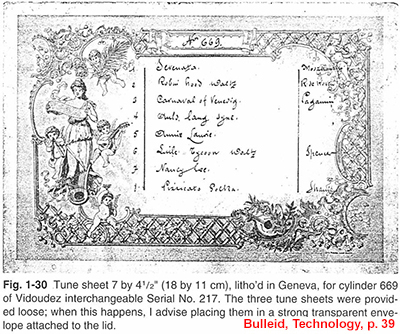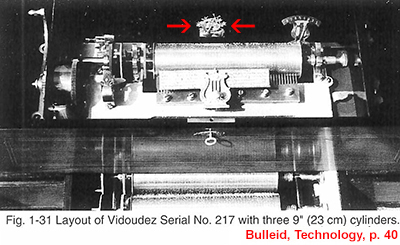
Bulleid, Technology, to Vidoudez
The tune sheet shown in Fig. 1-30 is another of those rather anonymous types which occasionally turn up at auctions. It [...] belongs to an interchangeable box made by H. Vidoudez of Ste. Croix.

Coin-operated cylinder musical boxes
Coin-operated cylinder musical boxes became very popular in Swiss (and I [=H. A. V. Bulleid] think also in French) railway stations towards the end of the 19th century, and two known makers were Vidoudez and Lassueur, both of Ste. Croix. Several are still to be found, including a sublime harmonie complete with dancing dolls in the Ste. Croix station, now with electric drive. It was made by Lassueur who sometimes fitted, as an optional extra, a small pistol loaded with a blank cartridge. It went off if anyone tried to force the coin drawer, thereby causing flash marks and a lot of annoyance to intending thieves.
Serial N° 217
Vidoudez also made at least two types of nickel-plated interchangeable-cylinder boxes. Fig. 1-31 shows Serial No. 217,
 supplied with three eight air 9“ (23 cm) cylinders Nos. 664, 669 and 671. Cylinder diameter was 2“ (5 cm). The comb had 50 teeth, with a zither that I think was originally arranged with snail cams on great wheels (unnecessarily gear-cut) but they worked the opposite way from normal. The arbor was extended at both ends, carrying the drive-plate at the left side and handling knob at the treble end. supplied with three eight air 9“ (23 cm) cylinders Nos. 664, 669 and 671. Cylinder diameter was 2“ (5 cm). The comb had 50 teeth, with a zither that I think was originally arranged with snail cams on great wheels (unnecessarily gear-cut) but they worked the opposite way from normal. The arbor was extended at both ends, carrying the drive-plate at the left side and handling knob at the treble end.
The lever-wind set up was standard except that the spring barrel drove a lay-shaft instead of the cylinder arbor. This lay-shaft carried a great wheel which drove the governor and the interchangeable drive plate. Lifting a cylinder in or out was very easy and good guides minimized risks to the comb teeth. A snag was that the conventionally mounted on/off and tune change levers had to reach the governor and the snail at the far end of the bedplate, necessitating long levers. Also, mounting the tune indicator at the opposite end of the cylinder from the snail meant that all cylinders had to be exactly the same length over end-caps.
The case, with transfer-decorated lid, was 26 ½ by 11 ¾ by 10 ¼“ high (67 by 30 by 26 cm), including the cylinder drawer. This configuration gave a sizeable soundboard so the bass notes came over well. The music was good for so few teeth, and the notorious Pizzicato Polka was very creditably performed. An unusual tune on cylinder 671 was Rubinstein´s Melody in F.
Cylinder 664 had Faust up to date, composed by Lutz in 1888, wrongly atrributed but useful in fixing manufacture as 1889 or later.
Larger Vidoudez interchangeables
The larger Vidoudez interchangeables were of similar mechanism and case layout but their eight-air cylinders were 13“ (33 cm) long and 2 ½“ (6 cm) diameter. The combs had 73 teeth. Hey! Why only 73 teeth for a 13“ cylinder, one might ask, when a 13 ¼“ (33 cm) Nicole has 93 teeth. The explanation is that these Vidoudez interchangeables used the same coarse tune tracks as contemporary Mermods and Paillards, namely 0.022“ (0.56 mm) per track instead of the traditional 0.017“ (0.43 mm). This size allowed less precise cylinder pinning and wider tooth tips and reduced the change of garbling due to errors in cylinder dimensions. However, it was a sign of cheapening standards, the number of teeth in a comb of given length being reduced by 25%. For these boxes the formula relating the number of teeth (T) to cylinder length in inches is:
T = (45 times cyl. length) divides by numbers of tunes.
The main distinguishing mark on Vidoudez boxes was a gilt metal pressing inside the case, as seen in Fig. 1-31:

(detail of the next:)

They also incorporated a gravity check, as explained in Chapter 5,
(Bulleid, Technology, p. 40-42)

|

 supplied with three eight air 9“ (23 cm) cylinders Nos. 664, 669 and 671. Cylinder diameter was 2“ (5 cm). The comb had 50 teeth, with a zither that I think was originally arranged with snail cams on great wheels (unnecessarily gear-cut) but they worked the opposite way from normal. The arbor was extended at both ends, carrying the drive-plate at the left side and handling knob at the treble end.
supplied with three eight air 9“ (23 cm) cylinders Nos. 664, 669 and 671. Cylinder diameter was 2“ (5 cm). The comb had 50 teeth, with a zither that I think was originally arranged with snail cams on great wheels (unnecessarily gear-cut) but they worked the opposite way from normal. The arbor was extended at both ends, carrying the drive-plate at the left side and handling knob at the treble end.
